DeWalt DW920K-2 Handleiding
DeWalt
Boormachine
DW920K-2
Bekijk gratis de handleiding van DeWalt DW920K-2 (7 pagina’s), behorend tot de categorie Boormachine. Deze gids werd als nuttig beoordeeld door 105 mensen en kreeg gemiddeld 4.4 sterren uit 53 reviews. Heb je een vraag over DeWalt DW920K-2 of wil je andere gebruikers van dit product iets vragen? Stel een vraag
Pagina 1/7

INSTRUCTION MANUAL
GUIDE D'UTILISATION
MANUAL DE INSTRUCCIONES
DW920
7.2 Volt Heavy Duty Cordless Screwdriver
Tournevis 7,2 volt sans fil de service intensif
Destornillador de 7,2 volt para trabajo pesado
INSTRUCTIVO DE OPERACIÓN, CENTROS DE SERVICIO Y
PÓLIZA DE GARANTÍA. ADVERTENCIA: LÉASE ESTE
INSTRUCTIVO ANTES DE USAR EL PRODUCTO.
IF YOU HAVE ANY QUESTIONS OR COMMENTS ABOUT THIS OR ANY DEWALT TOOL,
CALL US TOLL FREE AT:
1-800-4-DEWALT (1-800-433-9258)
General Safety Rules – For All Battery Operated Tools
WARNING! Read and understand all instructions. Failure to follow all instructions listed
below may result in electric shock, fire and/or serious personal injury.
SAVE THESE INSTRUCTIONS
WORK AREA
• Keep your work area clean and well lit. Cluttered benches and dark areas invite acci-
dents.
• Do not operate power tools in explosive atmospheres, such as in the presence of
flammable liquids, gases, or dust. Power tools create sparks which may ignite the dust or
fumes.
• Keep bystanders, children, and visitors away while operating a power tool. Distrac-
tions can cause you to lose control.
ELECTRICAL SAFETY
• Do not abuse the cord. Never use the cord to carry the tool. Keep cord away from heat, oil,
sharp edges or moving parts. Replace damaged cords immediately. Damaged cords may create
a fire.
• A battery operated tool with integral batteries or a separate battery pack must be
recharged only with the specified charger for the battery. A charger that may be suit-
able for one type of battery may create a risk of fire when used with another battery.
• Use battery operated tool only with the specifically designated battery pack. Use of
any other batteries may create a risk of fire.
PERSONAL SAFETY
• Stay alert, watch what you are doing and use common sense when operating a
power tool. Do not use tool while tired or under the influence of drugs, alcohol, or medica-
tion. A moment of inattention while operating power tools may result in serious personal
injury.
• Dress properly. Do not wear loose clothing or jewelry. Contain long hair. Keep your hair,
clothing, and gloves away from moving parts. Loose clothing, jewelry, or long hair can be
caught in moving parts.
• Avoid accidental starting. Be sure switch is in the locked or off position before insert-
ing battery pack. Carrying tools with your finger on the switch or inserting the battery pack
into a tool with the switch on invites accidents.
• Remove adjusting keys or wrenches before turning the tool on. A wrench or a key that
is left attached to a rotating part of the tool may result in personal injury.
• Do not overreach. Keep proper footing and balance at all times. Proper footing and bal-
ance enables better control of the tool in unexpected situations.
• Use safety equipment. Always wear eye protection. Dust mask, non-skid safety shoes,
hard hat, or hearing protection must be used for appropriate conditions.
TOOL USE AND CARE
• Use clamps or other practical way to secure and support the workpiece to a stable
platform. Holding the work by hand or against your body is unstable and may lead to a loss
of control.
• Do not force tool. Use the correct tool for your application. The correct tool will do the job
better and safer at the rate for which it is designed.
• Do not use tool if switch does not turn it on or off. A tool that cannot be controlled with
the switch is dangerous and must be repaired.
• Disconnect battery pack from tool or place the switch in the locked or off position
before making any adjustments, changing accessories, or storing the tool. Such pre-
ventative safety measures reduce the risk of starting the tool accidentally.
• Store idle tools out of reach of children and other untrained persons. Tools are dan-
gerous in the hands of untrained users.
• When battery pack is not in use, keep it away from other metal objects like: paper
clips, coins, keys, nails, screws, or other small metal objects that can make a con-
nection from one terminal to another. Shorting the battery terminals together may cause
sparks, burns, or a fire.
• Maintain tools with care. Keep cutting tools sharp and clean. Properly maintained tools,
with sharp cutting edges are less likely to bind and are easier to control.
• Check for misalignment or binding of moving parts, breakage of parts, and any other
condition that may affect the tools operation. If damaged, have the tool serviced before
using. Many accidents are caused by poorly maintained tools.
• Use only accessories that are recommended by the manufacturer for your model.
Accessories that may be suitable for one tool, may create a risk of injury when used on
another tool.
SERVICE
• Tool service must be performed only by qualified repair personnel. Service or mainte-
nance performed by unqualified personnel may result in a risk of injury.
• When servicing a tool, use only identical replacement parts. Follow instructions in the
Maintenance section of this manual. Use of unauthorized parts or failure to follow
Maintenance Instructions may create a risk of shock or injury.
Additional Safety Rules
• Hold tool by insulated gripping surfaces when performing an operation where the
tool may contact hidden wiring. Contact with a “live” wire will also make exposed metal
parts of the tool “live” and shock the operator.
•When working on a ladder or on scaffolding be sure to lay the tool down on its side
when not in use. Some tools with large battery packs will stand upright but may be easily
knocked over.
• The label on your tool may include the following symbols.
V....................volts A ............amperes
Hz..................hertz W ..........watts
min ................minutes ..........alternating current
..............direct current ..........Class II Construction
no ..................no load speed …/min ....revolutions or reciprocation per minute
..................earthing terminal ..........safety alert symbol
WARNING: Some dust created by power sanding, sawing, grinding, drilling, and other con-
struction activities contains chemicals known to cause cancer, birth defects or other reproduc-
tive harm. Some examples of these chemicals are:
• lead from lead-based paints,
• crystalline silica from bricks and cement and other masonry products, and
• arsenic and chromium from chemically-treated lumber (CCA).
Your risk from these exposures varies, depending on how often you do this type of work. To
reduce your exposure to these chemicals: work in a well ventilated area, and work with
approved safety equipment, such as those dust masks that are specially designed to filter out
microscopic particles.
Important Safety Instructions for Battery Packs
The battery pack is not fully charged out of the carton! First read the safety instruc-
tions below. Then follow charging notes and procedures.
READ ALL INSTRUCTIONS.
• Do not incinerate the battery pack even if it is severely damaged or is completely worn out.The
battery pack can explode in a fire.
• A small leakage of liquid from the battery pack cells may occur under extreme usage or temper-
ature conditions. This does not indicate a failure. However, if the outer seal is broken and this
leakage gets on your skin:
a. Wash quickly with soap and water.
b. Neutralize with a mild acid such as lemon juice or vinegar.
c. If battery liquid gets into your eyes, flush them with clean water for a minimum of 10 minutes
and seek immediate medical attention. (Medical note: The liquid is 25-35% solution of potassi-
um hydroxide.)
• Do not carry extra battery packs in aprons, pockets, or tool boxes along with other metal objects.
Battery pack could be short circuited causing damage to the battery pack and possibly causing
severe burns or fire.
• Charge the battery packs only in DEWALT chargers.
•NOTE:The batteries in your battery pack are the nickel–cadmium type. Cadmium is considered
to be a toxic material by the Environmental Protection Agency. Before disposing of damaged or
worn out Nickel–Cadmium battery packs, check with your state Environmental Protection Agency
to find out about special restrictions on the disposal of these battery packs or return them to a
DEWALT certified service center for recycling.
•DO NOT store or use the tool and battery pack in locations where the temperature may reach or
exceed 105°F (such as outside sheds or metal buildings in summer).
DANGER: Never attempt to open the battery pack for any reason. If battery pack case is
cracked or damaged, do not insert into charger. Danger of electric shock or electrocution.
Damaged battery packs should be returned to service center for recycling.
Installing and Removing the Battery Pack
NOTE: Make sure your battery pack is fully charged.
To install the battery pack into the tool handle, align the base of the tool with the notch
inside the tool’s handle (FIG. 2) and slide the battery pack firmly into the handle until you hear
the lock snap into place as shown in FIG. 3.
To remove the battery pack from the tool, press the release buttons and firmly pull the bat-
tery pack out of the tool handle. Insert it into the charger as described in the charger section
of this manual.
The RBRC™ Seal
The RBRC™ (Rechargeable Battery Recycling Corporation) Seal on the nickel-
cadmium battery (or battery pack) indicates that the costs to recycle the battery
(or battery pack) at the end of its useful life have already been paid by D EWALT.
In some areas, it is illegal to place spent nickel-cadmium batteries in the trash or
municipal solid waste stream and the RBRC program provides an environmen-
tally conscious alternative.
RBRC in cooperation with DEWALT and other battery users, has established programs in the
United States to facilitate the collection of spent nickel-cadmium batteries. Help protect our
environment and conserve natural resources by returning the spent nickel-cadmium battery to
an authorized DEWALT service center or to your local retailer for recycling. You may also con-
tact your local recycling center for information on where to drop off the spent battery.
Important Safety Instructions for Battery Chargers
SAVE THESE INSTRUCTIONS - This manual contains important safety instructions for
DEWALT battery chargers.
• Before using battery charger, read all instructions and cautionary markings on battery char-
ger, battery and product using battery.
CAUTION:To reduce the risk of injury, charge only DEWALT nickel cadmium rechargeable
batteries. Other types of batteries may burst causing personal injury and damage.
CAUTION: Under certain conditions, with the charger plugged in to the power supply, the
exposed charging contacts inside the charger can be shorted by foreign material. Foreign
materials of a conductive nature such as, but not limited to, steel wool, aluminum foil, or any
buildup of metallic particles should be kept away from charger cavities. Always unplug the
charger from the power supply when there is no battery pack in the cavity. Unplug charger
before attempting to clean.
DANGER: 120 volts present at charging terminals. Do not probe with conductive objects.
Danger of electric shock or electrocution.
WARNING: Don’t allow any liquid to get inside charger. Electric shock may result.
• The charger and battery pack are specifically designed to work together. attempt toDO NOT
charge the battery pack with any chargers other than the ones in this manual.
• These chargers are not intended for any uses other than charging DEWALT rechargeable batteries.
Any other uses may result in risk of fire, electric shock or electrocution.
DEWALT Industrial Tool Co., 701 East Joppa Road, Baltimore, MD 21286
Printed in China (JUN00) Form No.497947 DW920 Copyright © 2000
Questions? See us in the World Wide Web at www.dewalt.com

The variable speed switch enables you to start the application at a slow speed. The farther
you squeeze the trigger, the faster the tool will operate. For maximum tool life, use variable
speed only for starting holes or fasteners.
NOTE: Continuous use in variable speed range is not recommended. It may damage the
switch and should be avoided.
Forward/Reverse Control Button (Fig. 4)
A forward/reverse control button (B) determines the direction the chuck will spin and also
serves as a lock off button. The center position of the control button locks the tool in the off
position. When changing the position of the control button, be sure the trigger is released.
NOTE: The first time the tool is run after changing the direction of rotation, you may hear a
click on start up. This is normal and does not indicate a problem.
Two Position Screwdriver (Fig. 4)
To convert the tool to an angled screwdriver pull back on the release button (C) and rotate the
top portion of the tool as shown.
TWO POSITION SCREWDRIVER WARNINGS:
• To avoid being pinched, hold the screwdriver and keep hands away from the hinge when
changing positions.
• Do not use screwdriver as a pry bar in either position.
• To avoid screwdriver being turned on accidentally, put the Forward/Reverse switch in the
center, locked-off, position.
Torque Adjustment Collar (Fig. 5)
The torque adjustment collar (A) is marked with numbers and a drill bit symbol. The higher the
number on the collar, the higher the torque. To lock the clutch for drilling operations, move to
the drill bit position. Failure to do this will allow the clutch to slip while attempting to drill.
Quick Release Chuck (Fig. 5)
NOTE: The chuck accepts 1/4" hex accessories only.
To install a bit, insert the bit into the chuck until the clip locks it in place.
To remove a bit, pull the chuck (B) back. Remove the bit and release the chuck.
Operation as a Drill
Turn the collar to the drill bit symbol. Install the hex shank drill bit in the chuck. Follow these
instructions for best results when drilling.
DRILLING
1. Use DEWALT hex shank drill bits only.
2. Be sure the material to be drilled is anchored or clamped firmly. If drilling thin material, use
a “back-up” block to prevent damage to the material.
3. Always apply pressure in a straight line with the bit. Use enough pressure to keep the drill bit
biting, but do not push hard enough to stall the motor or deflect the bit.
4. Hold tool firmly to control the twisting action of the drill.
5. IF TOOL STALLS, it is usually because it is being overloaded. RELEASE TRIGGER
IMMEDIATELY, remove drill bit from work, and determine cause of stalling. DO NOT CLICK
TRIGGER OFF AND ON IN AN ATTEMPT TO START A STALLED TOOL – THIS CAN
DAMAGE THE TOOL.
6. To minimize stalling or breaking through the material, reduce pressure on tool and ease the
bit through the last fractional part of the hole.
7. Keep the motor running when pulling the bit back out of a drilled hole. This will help prevent
jamming.
8. With variable speed drills there is no need to center punch the point to be drilled. Use a slow
speed to start the hole and accelerate by squeezing the trigger harder when the hole is deep
enough to drill without the bit skipping out. Operate at full on after starting the bit.
Operation as a Screwdriver
Insert the appropriate hex shank bit into the chuck. Make a few practice runs in scrap or
unseen areas to determine the proper position of the torque adjustment collar.
Maintenance
CLEANING: With the motor running, blow dirt and dust out of all air vents with dry air at least
once a week. Wear safety glasses when performing this task. Exterior plastic parts may be
cleaned with a damp cloth and mild detergent. Although these parts are solvent resistant, sol-
vents should not be used for cleaning.
CHARGER CLEANING INSTRUCTIONS:
WARNING: Disconnect the charger from the AC outlet before cleaning.
Dirt and grease may be removed from the exterior of the charger using a cloth or soft non-
metallic brush. Do not use water or any cleaning solutions.
Accessories
Recommended accessories for use with your tool are available for purchase from your local
service center.
The bit shown in Figure 6 is typical of the bits for use in the Quick Release Chuck with a
groove (A) which is required to hold the bit firmly.
CAUTION: The use of any non-recommended accessory may be hazardous.
If you need any assistance in locating any accessory, please contact D EWALT Industrial Tool
Co., 701 East Joppa Road, Baltimore, MD 21286 or call 1-800-4-D EWALT. (1-800-433-9258)
Maximum Recommended Capacity
BITS, DRILLING 1/8"
Important
To assure product SAFETY and RELIABILITY, repairs, maintenance and adjustment should
be performed by certified service centers or other qualified service organizations, always
using identical replacement parts.
Full Warranty
DEWALT heavy duty industrial tools are warranted for one year from date of purchase. We will
repair, without charge, any defects due to faulty materials or workmanship. For warranty repair
information, call 1-800-4-DEWALT. This warranty does not apply to accessories or damage
caused where repairs have been made or attempted by others. This warranty gives you specif-
ic legal rights and you may have other rights which vary in certain states or provinces.
In addition to the warranty, D WALT tools are covered by our:E
30 DAY NO RISK SATISFACTION GUARANTEE
If you are not completely satisfied with the performance of your DEWALT heavy duty industrial
tool, simply return it to the participating seller within 30 days for a full refund. Please return the
complete unit, transportation prepaid. Proof of purchase may be required.
• To reduce risk of damage to electric plug and cord, pull by plug rather than cord when disconnecting
charger.
• Make sure cord is located so that it will not be stepped on, tripped over, or otherwise subjected to
damage or stress.
• An extension cord should not be used unless absolutely necessary. Use of improper extension cord
could result in risk of fire, electric shock, or electrocution.
• An extension cord must have adequate wire size (AWG or American Wire Gauge) for safety. The
smaller the gauge number of the wire, the greater the capacity of the cable, that is 16 gauge has
more capacity than 18 gauge. When using more than one extension to make up the total length, be
sure each individual extension contains at least the minimum wire size.
Recommended Minimum AWG Size for Extension Cords
Total Extension Cord Length (feet)
25 50 75 100 125 150 175
Wire Gauge
18 18 16 16 14 14 12
• The charger is ventilated through slots in the top and the bottom of the housing. Do not place any
object on top of charger or place the charger on a soft surface that might block the ventilation slots
and result in excessive internal heat. Place the charger in a position away from any heat source.
• Do not operate charger with damaged cord or plug — have them replaced immediately.
• Do not operate charger if it has received a sharp blow, been dropped, or otherwise damaged in any
way; take it to an authorized service center.
• Do not disassemble charger; take it to an authorized service center when service or repair is
required. Incorrect reassembly may result in a risk of electric shock, electrocution or fire.
• To reduce risk of electric shock, unplug charger from outlet before attempting any cleaning.
Removing the battery pack will not reduce this risk.
•NEVER attempt to connect 2 chargers together.
• The charger is designed to operate on standard household electrical power (120 Volts AC). Do not
attempt to use it on any other voltage! This does not apply to vehicular charger.
Chargers
Your battery can be charged in D WALT 1 Hour Chargers, 15 Minute Chargers or Vehicular 12E
volt charger. Be sure to read all safety instructions before using your charger.
Consult chart on back cover for compatibility of chargers and battery packs.
Charging Procedure
1 HOUR CHARGERS
1. Plug the charger into an appropriate power outlet.
2. Insert the battery pack into the charger, as shown in FIG.1, making sure the pack is fully
seated in the charger. The red (charging) light will blink continuously indicating that the
charging process has started.
3. The battery pack will be fully charged in about 1 hour. The completion of charge will be indi-
cated by the red light remaining ON continuously. The pack is fully charged and may be
used at this time or left in the charger.
TROUBLE INDICATORS: These chargers are designed to detect certain problems that can
arise with battery packs which would be indicated by the red light flashing at a fast rate (and
continuous beeping for 15 Minute Chargers). If this occurs, re-insert battery pack. If problem
persists, try a different battery pack to determine if the charger is OK. If the new pack charges
correctly, then the original pack is defective and should be returned to a service center for
recycling. If the new battery pack elicits the same trouble indication as the original, have
charger tested at an authorized service center.
PROBLEM POWER LINE
If your charger has a Problem Power Line indicator: When the charger ‘is used with some
portable power sources such as generators or sources that convert DC to AC, the charger may
temporarily suspend operation, flashing the red light with two fast blinks followed by a
pause. This indicates the power source is out of limits.
HOT PACK DELAY
If your charger has a Hot Pack Delay feature: When the charger detects a battery that is hot, it
automatically starts a Hot Pack Delay, suspending charging until the battery has cooled. After
the battery has cooled, the charger automatically switches to the Pack Charging mode. This
feature ensures maximum battery life. The red light flashes long, then short while in the Hot
Pack Delay mode.
15 MINUTE CHARGERS
1. Plug the charger into an appropriate power outlet. The charger will beep twice, the red light
will blink and go off.
2. Insert the battery pack into the charger, as shown in FIG. 1, making sure the pack is fully
seated in the charger. The red light will blink and the charger will beep once indicating the
charging process has started.
3. The battery pack will be fully charged in less than 15 minutes under most conditions. This
will be indicated by the red light remaining ON and 3 beeps. The pack is fully charged and
may be used at this time or left in the charger.
WEAK BATTERY PACKS: The charger can also detect a weak battery. Such batteries are
still usable but should not be expected to perform as much work. In such cases, about 10 sec-
onds after battery insertion, the charger will beep rapidly 8 times to indicate a weak battery
condition. The charger will then go on to charge the battery to the highest capacity possible.
ALL CHARGERS
Leaving the battery pack in the charger: When the red light remains ON, the charger has
switched to its "equalize charge" mode which lasts approximately 4 hours, after which the
charger will switch to "maintenance charge" mode. The battery pack can be removed at any
time during these charge cycles, but will only be fully charged if the red light is continuously
ON. The charger and battery pack can be left connected with the red light glowing indefinite-
ly. The charger will keep the battery pack fresh and fully charged. A battery pack will slowly
lose its charge when kept out of the charger. If the battery pack has not been kept on main-
tenance charge, it may need to be recharged before use. A battery pack may also slowly lose
its charge if left in a charger that is not plugged into an appropriate AC source.
Important Charging Notes
1. Longest life and best performance can be obtained if the battery pack is charged when the air
temperature is between 65°F and 75°F (18°- 24°C). DO NOT charge the battery pack in an air
temperature below +40°F(+4.5°C), or above +105°F (+40.5°C). This is important and will
prevent serious damage to the battery pack.
2. The charger and battery pack may become warm to touch while charging. This is a normal
condition, and does not indicate a problem.
3. If the battery pack does not charge properly — (1) Check current at receptacle by plugging in a
lamp or other appliance, (2) Check to see if receptacle is connected to a light switch which turns
power off when you turn out the lights. (3) Move charger and battery pack to a location where
the surrounding air temperature is approximately 65°F - 75°F (18°- 24°C). (4) If charging
problems persist, take or send the tool, battery pack and charger to your local service center.
4. The battery pack should be recharged when it fails to produce sufficient power on jobs which
were easily done previously. DO NOT CONTINUE to use under these conditions. Follow the
charging procedure. You may also charge a partially used pack whenever you desire with no
adverse affect on the battery pack.
5. Do not immerse charger in water or any other liquid.
WARNING: Don't allow any liquid to get inside charger. Electric shock may result. To facili-
tate the cooling of the battery pack after use, avoid placing the charger or battery pack in a
warm environment such as in a metal shed, or an uninsulated trailer.
CAUTION: Never attempt to open the battery pack for any reason. If the plastic housing of
the battery pack breaks or cracks, return to a service center for recycling.
Operation
READ ALL OF THE INSTRUCTIONS IN THE BATTERY CHARGER SECTION OF THIS
MANUAL BEFORE ATTEMPTING TO CHARGE THE BATTERY PACK FOR YOUR TOOL.
Always use correct battery pack (pack supplied with tool or replacement pack exactly like it.)
Never install any other battery pack. It will ruin your tool and may create a hazardous condi-
tion.
Variable Speed Switch (Fig. 4)
To turn the tool on, squeeze the trigger switch (A). To turn the tool off, release the trigger
switch. Your tool is equipped with a brake. The chuck will stop as soon as the trigger switch
is fully released.

SI VOUS AVEZ DES QUESTIONS OU VOULEZ NOUS FAIRE PART DE VOS OMMEN-
TAIRES CONCERNANT CET OUTIL OU TOUT AUTRE OUTIL DEWALT, COMPOSEZ SANS
FRAIS LE :1 800 433-9258.
Règles générales de sécurité concernant les outils à
piles
AVERTISSEMENT! Lire et comprendre toutes les directives, car le non-respect des direc-
tives suivantes pourrait entraîner un choc électrique, un incendie ou des blessures graves.
CONSERVER CES DIRECTIVES
ZONE DE TRAVAIL
· Garder la zone de travail propre et bien éclairée; les établis encombrés et les endroits som-
bres sont propices aux accidents.
· Ne pas utiliser les outils électriques dans une atmosphère explosive, comme à proximité de
liquides, de gaz ou de poussières inflammables; le moteur peut créer des étincelles et
enflammer les vapeurs ou les poussières environnantes.
· Tenir les enfants, les visiteurs ou toute autre personne à l’écart lorsqu’on utilise un outil élec-
trique; les distractions peuvent faire perdre la maîtrise de ce dernier.
MESURES DE SÉCURITÉ : ÉLECTRICITÉ
·Ne pas utiliser le cordon de manière abusive; on ne doit pas transporter l’outil en le ten-
ant par le cordon. On doit tenir le cordon à l’écart des sources de chaleur, de l’huile, des
bords tranchants ou des pièces mobiles. Remplacer immédiatement les cordons endom-
magés, car ces derniers augmentent les risques d’incendie.
· Un outil à piles intégrées ou à bloc-piles externe doit être rechargé seulement au
moyen du chargeur approprié, car un chargeur destiné à une pile particulière pourrait
entraîner un risque d’incendie lorsqu’il est utilisé avec une autre.
· N’utiliser l’outil à piles qu’avec le bloc-piles désigné, car l’utilisation d’un autre type de
piles pourrait entraîner un risque d’incendie.
SÉCURITÉ PERSONNELLE
· Rester vigilant en tout temps et faire preuve de jugement lorsqu’on utilise un outil
électrique; ne pas utiliser l’outil lorsqu’on est fatigué ou sous l’influence de drogues, d’al-
cool ou de médicaments, car un moment d’inattention pourrait entraîner des blessures
graves.
· Porter des vêtements appropriés; ne pas porter de vêtements amples ni de bijoux.
Couvrir ou attacher les cheveux longs. Garder les cheveux, les vêtements, les bijoux et les
gants éloignés des pièces mobiles, car ceux-ci peuvent s’y coincer.
· Éviter les démarrages accidentels; s’assurer que l’interrupteur soit placé en position de
verrouillage ou d’arrêt avant d’insérer le bloc-piles. Ne pas transporter l’outil en laissant le
doigt sur l’interrupteur ni insérer le bloc-piles lorsque l’outil est en position de marche, car
cela pourrait causer un accident.
· Retirer les clés de réglage avant de démarrer l’outil; une clé laissée sur une pièce rota-
tive pourrait entraîner des blessures.
· Ne pas trop étendre les bras; les pieds doivent rester ancrés fermement sur le sol afin de
maintenir son équilibre en tout temps et de mieux maîtriser l’outil dans des situations
imprévues.
· Utiliser le matériel de sécurité approprié; toujours porter des lunettes de protection.
Porter un masque anti-poussières, des chaussures antidérapantes, un casque de sécurité
ou des protecteurs auditifs lorsque la situation le requiert.
UTILISATION ET ENTRETIEN DE L’OUTIL
· Fixer et soutenir l’ouvrage sur une plate-forme stable au moyen d’un étau ou de tout
autre dispositif semblable; l’ouvrage est instable lorsqu’on le retient manuellement ou
qu’on l’appuie contre le corps, ce qui pourrait faire perdre la maîtrise de l’outil.
· Ne pas forcer l’outil ni l’utiliser pour des travaux autres que ceux pour lesquels il a
été conçu. Pour obtenir de meilleurs résultats et prévenir les risques de blessure, laisser
l’outil couper à la vitesse pour laquelle il a été conçu.
· Ne pas utiliser l’outil lorsque l’interrupteur de marche-arrêt ne fonctionne pas; tout
outil qui ne peut être commandé au moyen de l’interrupteur est dangereux et doit être
réparé.
· Débrancher le bloc-piles de l’outil ou mettre l’interrupteur en position de verrouillage
ou d’arrêt avant d’effectuer un réglage, de changer les accessoires ou de ranger
l’outil; ces mesures de sécurité préventives réduisent les risques de démarrage accidentel.
· Lorsqu’on n’utilise pas l’outil, le ranger hors de la portée des enfants ou des person-
nes non qualifiées; les outils sont dangereux entre les mains de personnes inexpérimen-
tées.
· Lorsqu’on n’utilise pas le bloc-piles, le ranger à l’écart des objets métalliques tels que les
trombones, les pièces de monnaie, les clés, les clous, les vis ou autres petits objets sus-
ceptibles de conduire l’électricité entre les bornes et d’occasionner ainsi des étincelles, des
brûlures ou un incendie.
· Bien entretenir l’outil; s’assurer qu’il soit toujours bien propre et aiguisé. Les outils bien
entretenus et dont les bords sont bien tranchants sont moins susceptibles de rester coincés
et sont plus faciles à maîtriser.
· Vérifier les pièces mobiles afin de s’assurer qu’elles soient bien alignées et qu’elles
ne restent pas coincées; vérifier également les pièces afin de s’assurer qu’il n’y ait aucun
bris ni aucune autre condition susceptible de nuire au bon fonctionnement de l’outil. Faire
réparer l’outil si ce dernier est endommagé avant de s’en servir à nouveau, car les accidents
sont souvent causés par des outils mal entretenus.
· N’utiliser que les accessoires recommandés par le fabricant pour le modèle con-
cerné; un accessoire destiné à un outil particulier peut devenir dangereux lorsqu’il est util-
isé avec un autre.
ENTRETIEN
· L’outil doit être entretenu ou réparé par le personnel qualifié seulement; toute main-
tenance effectuée par une personne non qualifiée pourrait entraîner des risques de
blessure.
· Lors de l’entretien, n’utiliser que des pièces de rechange identiques et suivre les direc-
tives de la section «Entretien» du présent manuel afin de prévenir les risques de choc élec-
trique ou de blessure.
Règles de sécurité additionnelles
· Tenir l’outil par les surfaces isolées prévues à cette fin lorsque l’outil risque d’entrer
en contact avec des fils cachés, car de tels contacts peuvent mettre les pièces
métalliques de l’outil sous tension, engendrant des risques de choc électrique.
· Lorsqu’on est installé sur une échelle ou un échafaudage pour travailler, on doit
déposer l’outil sur le côté lorsqu’on ne s’en sert plus. Bien que certains outils munis
d’un gros bloc-piles puissent être placés à la verticale, dans cette position, ils peuvent facile-
ment être renversés.
• L’étiquette de l’outil peut comporter les symboles suivants.
V..............volts A ..................ampères
Hz............hertz W ................watts
min ..........minutes ................courant alternatif
........courant continu no ................sous vide
............Construction de classe II ..................borne de mise à la minute
............symbole d´avertissement .../min ..........tours ou courses à la minute
AVERTISSEMENT : Certains outils, tels que les sableuses électriques, les scies, les meules,
les perceuses ou certains autres outils de construction, peuvent soulever de la poussière con-
tenant des produits chimiques susceptibles d’entraîner le cancer, des malformations congéni-
tales ou pouvant être nocifs pour le système reproductif. Parmi ces produits chimiques, on
retrouve :
• le plomb dans les peintures à base de plomb;
• la silice cristalline dans les briques et le ciment et autres produits de maçonnerie;
• l’arsenic et le chrome dans le bois de sciage ayant subi un traitement chimique (CCA).
Le risque associé à de telles expositions peut varier selon la fréquence avec laquelle on effectue
ces travaux. Pour réduire l’exposition à de tels produits, il faut travailler dans un endroit bien ven-
tilé et utiliser l’équipement de sécurité approprié tel un masque anti-poussières spécialement
conçu pour filtrer les particules microscopiques.
Importantes consignes de sécurité concernant le bloc-
piles
Le bloc-piles n’est pas complètement chargé au moment de sa livraison! Avant de le charger,
lire attentivement toutes les consignes de sécurité énumérées ci-dessous, ainsi que les remar-
ques, les notes et les méthodes de chargement.
· Ne pas incinérer le bloc-piles, même s’il a subi des dommages importants ou il est usé com-
plètement, car il pourrait exploser en présence de flammes.
· Les cellules du bloc-piles peuvent subir une fuite légère par suite d’un usage extrême ou
d’une exposition à certaines températures; ceci n’indique pas un problème. Cependant, si
le scellant externe est percé et le liquide entre en contact avec la peau, on doit :
a. se laver rapidement la partie du corps touchée avec de l’eau savonneuse;
b. neutraliser l’effet au moyen d’un acide doux tel que du jus de citron ou du vinaigre;
c. si les yeux sont touchés, les rincer à fond avec de l’eau propre pendant au moins 10
minutes et consulter immédiatement un médecin. (Remarque aux fins médicales : ce liquide
contient une solution composée de 25 à 35 % d’hydroxyde de potassium.)
· Ne pas transporter de bloc-piles supplémentaires dans un tablier, une poche ou une boîte
à outils contenant des objets métalliques, car le bloc-pile pourrait causer un court-circuit et
s’endommager, ou risquer de provoquer de graves brûlures ou un incendie.
· Ne charger les bloc-piles qu’au moyen des chargeurs D EWALT.
· REMARQUE : le bloc-piles contient des piles au nickel-cadmium. Le cadmium est consid-
éré comme une substance toxique par les agences de protection de l’environnement, dont
le ministère de l’Environnement; on recommande donc de vérifier auprès de l’agence con-
cernée avant de mettre au rebut des bloc-piles au nickel-cadmium usés ou endommagés
afin de se renseigner sur les dispositions particulières qui s’appliquent dans votre région à
ce sujet, ou de retourner les bloc-piles usés ou endommagés à un centre de service quali-
fié DEWALT afin qu’ils puissent être recyclés.
·NE PAS ranger ni utiliser l’outil ou le bloc-piles dans des endroits où la température peut
atteindre ou dépasser 40,5 ºC (105 ºF), comme les cabanons ou les bâtiments en revête-
ment métallique durant l’été.
DANGER : ne jamais tenter d’ouvrir le bloc-piles pour quelle que raison que ce soit. Si le
compartiment se rupture ou subit des dommages, ne pas l’insérer dans le chargeur afin
d’éviter les risques de choc électrique ou d’électrocution. On doit retourner les bloc-piles
endommagés à un centre de service afin qu’ils puissent être recyclés.
Retrait et installation de l’ensemble de piles
NOTE : S’ASSUREER QUE L’ENSEMBLE DE PILES EST COMPLÈTEMENT CHARGÉ.
Pour installer l’ensemble de piles dans la poignée de l’outil, aligner le socle de l’outil sur
l’encoche à l’intérieur de la poignée de l’outil (figure 2) et faire glisser l’ensemble de piles fer-
mement dans la poignée jusqu’à ce qu’un déclic se fasse entendre (fig. 3).
Pour retirer l’ensemble de piles de l’outil, il suffit d’appuyer sur les boutons de dégagement
et de tirer fermement l’ensemble de piles hors de la poignée de l’outil. L’insérer dans le
chargeur de la façon décrite précédemment.
Sceau RBRCMC
Le sceau RBRCMC de la Rechargeable Battery Recycling Corporation apposé ur
sla pile au nickel-cadmium (ou le bloc-piles) indique que les coûts de recyclage de
ce dernier à la fin de sa vie utile ont déjà été payés par D EWALT. En certains
endroits, la mise au rebut ou aux ordures municipales des piles au nickel-cadmi-
um est illégale; le programme de «RBRC» constitue donc une solution des plus
pratiques et écologiques.
La «RBRC», en collaboration avec DEWALT et d’autres utilisateurs de piles, a mis sur pied des
programmes aux États-Unis dans le but de faciliter la collecte des piles déchargées. D EWALT
encourage ses utilisateurs à participer à son programme de protection de l'environnement et de
conservation des ressources naturelles en retournant les piles usagées à un centre de service
DEWALT ou chez un dépositaire local afin qu’elles puissent être recyclées. On peut en outre se
renseigner auprès d’un centre de recyclage local pour connaître d'autres sites les acceptant.
Importantes consignes de sécurité concernant les
chargeurs
CONSERVER CES DIRECTIVES – Le présent manuel contient d’importantes consignes de
sécurité concernant les chargeurs DEWALT.
· Avant d’utiliser le chargeur, lire toutes les directives et étiquettes de mise en garde
apposées sur le chargeur, la pile et le produit utilisant la pile.
MISE EN GARDE : afin de réduire les risques de blessure, ne charger que des piles au
nickel-cadmium rechargeables DEWALT, car les autres peuvent éclater et entraîner des
blessures ou des dommages matériels.
MISE EN GARDE : dans certaines conditions, lorsque le chargeur est enfiché, les raccords
de charge à nu situés à l’intérieur du chargeur peuvent subir un court-circuit lorsqu’ils
entrent en contact avec une matière étrangère. Les matières conductives comme la laine
d’acier, la feuille d’aluminium ou les particules métalliques, mais sans toutefois s’y limiter,
doivent être tenus à l’écart des cavités du chargeur. Toujours débrancher celui-ci lorsque le
bloc-piles n’y est pas inséré ou avant de le nettoyer.
DANGER : les bornes du chargeur conduisent une tension de 120 volts; on ne doit pas les
toucher au moyen d’objets conducteurs afin d’éviter les risques de choc électrique ou
d’électrocution.
AVERTISSEMENT : ne jamais laisser de liquide s’infiltrer à l’intérieur du chargeur afin
d’éviter les risques de choc électrique.
· Le chargeur et le bloc-piles sont conçus spécialement pour être utilisés ensemble; NE PAS
charger le bloc-piles au moyen d’un chargeur autre que ceux décrits dans le présent
manuel.
· N’utiliser ces derniers que pour charger les piles rechargeables D EWALT; tout autre usage
pourrait entraîner des risques d’incendie, de choc électrique ou d’électrocution.
· Afin de réduire les risques de dommage à la fiche ou au cordon électrique, débrancher le
A
FIG. 1
FIG. 3
FIG. 2 FIG. 4
A
B
(LEFT) C
FIG. 5
FIG. 6
B
A
Product specificaties
| Merk: | DeWalt |
| Categorie: | Boormachine |
| Model: | DW920K-2 |
Heb je hulp nodig?
Als je hulp nodig hebt met DeWalt DW920K-2 stel dan hieronder een vraag en andere gebruikers zullen je antwoorden
Handleiding Boormachine DeWalt
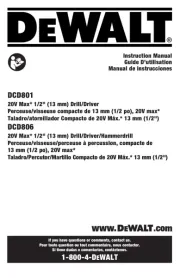
3 Augustus 2025
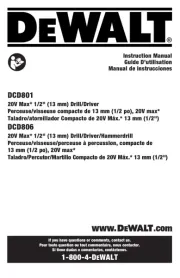
29 Juli 2025

4 Juli 2025
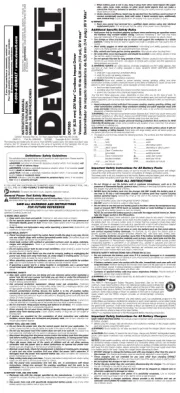
10 Juni 2025

2 Januari 2025

22 November 2024

15 November 2024

2 November 2024

23 September 2024

11 September 2024
Handleiding Boormachine
- Anova
- Luxor
- Max
- Bort
- Total
- Blucave
- Biltema
- Dremel
- Fieldmann
- Steren
- PHIOLENT
- Global
- Kinzo
- Ferrex
- Flex
Nieuwste handleidingen voor Boormachine
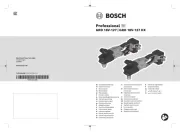
16 September 2025
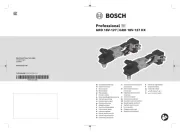
16 September 2025
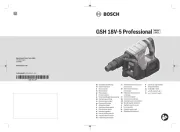
15 September 2025
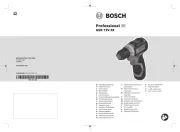
15 September 2025
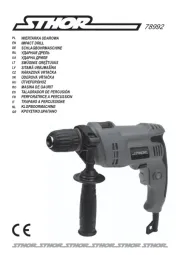
13 September 2025
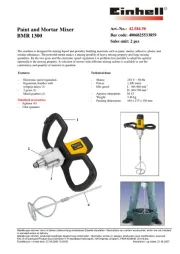
13 September 2025
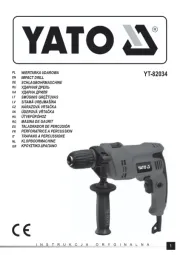
12 September 2025
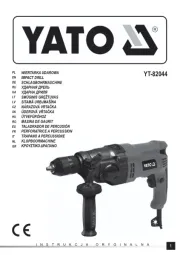
12 September 2025
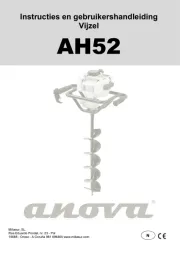
9 September 2025
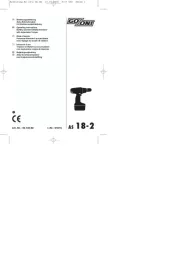
8 September 2025